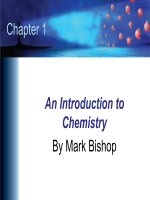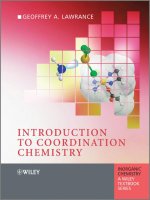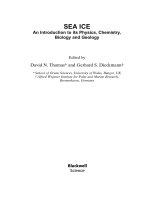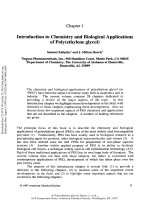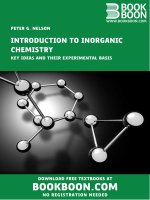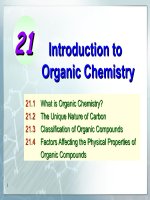Introduction to chemistry
Bạn đang xem bản rút gọn của tài liệu. Xem và tải ngay bản đầy đủ của tài liệu tại đây (693.3 KB, 43 trang )
Chemistry Unit Notes
8th Grade Science
Basic Vocabulary
Matter: Anything that has mass and volume
Mass: Amount of matter in an object
Weight: Measure of the force of attraction between
objects due to mass and gravity
Volume: Amount of space an object takes up
Density: Measurement of how much mass is
contained in a given volume
More Vocabulary
Atoms: Smallest particle of an element that has all the
properties of matter:
– Protons- particles in the nucleus with positive charge
– Electrons- particles orbiting around nucleus with negative charge
– Neutrons- particles in the nucleus with no charge
Elements: Simplest form of a pure substance
Compounds: Two or more elements chemically combined
to form a new substance
Sub-Atomic Particles
Part of
Atom
Charge
Location
Mass/Size
Electron
- negative
outside
nucleus
.0006 amu
(too little to count)
Proton
+ positive
inside nucleus 1 amu
Neutron
no charge
inside nucleus 1 amu
Periodic Table
Using the Periodic Table
17
Atomic Number
– Equal to # protons = # electrons
– Periodic Table is arranged by this number
Cl
35.5
Symbol
– “Shorthand” for the element – Note 2nd letter is
always lowercase
Atomic Mass Number
– Total AVERAGE mass of Protons + Neutrons +
Electrons
Electron Energy Levels
Electrons are arranged in “Shells” around nucleus in
predictable locations
Fill “seats” closest to nucleus first (concert – best seats)
“Seats” available
–
–
–
–
–
–
Shell #1
Shell #2
Shell #3
Shell #4
Shell #5
Shell #6
2 electrons
8 electrons
8 electrons
18 electrons
32 electrons
50 electrons
Ex. Carbon has 6 total electrons so…
Two electrons on first energy level
Four electrons on second energy level
Question: Could we fit more electrons on the second energy level if there were more electrons in carbon??
Atomic Structure
Total # of protons and electrons (in a neutral atom)
17 protons in nucleus
17 electrons orbiting nucleus
17
Cl
Element Name
Chlorine
35.5
Total Mass of Nucleus
36 - 17 = 18 neutrons
(Round Atomic Mass)
Notice: electrons follow energy level rules
from previous slide.
Atomic Mass – Fractions?
Look at Chlorine (atomic number 17)
Atomic mass of 35.5? I dont’ get it!
Where does the 35.5 come from?
– 0.5 protons? 0.5 neutrons? No
Atomic Mass = average number of protons
and neutrons in nature
More Practice
Determine the name, number of protons,
neutrons and electrons for each element
shown and draw…
15
8
26
P
O
Fe
31
16
56
Isotopes
An isotope is a variation of an element
(same protons) but can have diff. # of
neutrons
Ex: carbon (atomic mass = 12.011)
– Carbon (14) and carbon (12) exist in
nature
Ions
Change in electrons which gives an atom a
charge (+ or -)
You can only add or subtract electrons!
(protons don’t change)
– Ex. Count the number of electrons below…
Carbon ion (-1 charge)
7 electrons (-)
6 protons (+)
Neutral Carbon
6 electrons (-)
6 protons (+)
Carbon ion (+1 charge)
5 electrons (-)
6 protons (+)
Valence Electrons
An electron on the outermost energy shell of an atom
Important to understand because this is a key factor
in how atoms will BOND with each other
Octet rule – stable atom will have 8 electrons in that
outer shell
Practice – Valence # of
– Chlorine?
– Neon?
– Nitrogen?
– Oxygen?
Electron Dot Diagrams
a diagram that represents the # of valence
electrons in an atom of an element.
The amount of electrons is displayed by dots
around the symbol of the element.
Ex.
/>ssons/lesson38.htm
Types of Chemical Bonds
Ionic- Two elements bond by transferring electrons to create ions
that attract together (+ is attracted to - after an electron is transferred)
Covalent- Two elements bond by sharing electrons (strongest
bond type)
Metallic- Two metals bond and form a “common electron cloud”.
This is a cluster of shared electrons (weakest bond type)
Examples of Bonding
/> /> /> />
Predicting Bonds
Ionic Bond = metal to non-metal
Covalent = non-metal to non-metal
Metallic = metal to metal
Do you understand why? HINT: the numbers at the top of the table indicate the # of valence electrons for each column
Oxidation Numbers
Oxidation numbers are assigned to each element
They represent a predicted “charge” of an atom/ion
when it bonds with another element.
(tells us if the atom would prefer give or take electrons, and how many).
They help us to predict what compounds will form
when two elements get together.
Oxidation numbers are labeled like this:
Na 1+
O 2-
How to Use Oxidation Numbers
Oxidation Number indicates the number of electrons lost, gained or shared when
bonding with other atoms.
Ex. Na wants to lose an electron. If an electron is lost, it
becomes a +1 charge
SO: oxidation number for Na = 1+
Ex. Cl wants to gain an electron. If an electron is gained, it
becomes a -1 charge
SO: oxidation number for Cl = 1-
Oxidation Numbers
Each column going down the periodic table
has elements with the same oxidation
number.
Label the oxidation numbers on your periodic table at the top of each
column as shown here:
1+
2+
3+ 4(+/-) 3- 2- 1- 0
Rules for using oxidation
numbers to create compounds
1. Positive ions can only bond with negative ions and vice
versa
2. The sum of the oxidation numbers of the atoms in a
compound must be zero (the key is to stay balanced)
3. If the oxidation numbers are not equal to zero, then you
must add additional elements until they balance at zero.
4. When writing a formula the symbol of the Positive (+)
element is followed by the symbol of the negative (-)
element.
Examples of Forming Compounds
Ex. Na (+1) + Cl (-1) = NaCl
Are these oxidation numbers already equal to zero?
If so, you don’t need to add any extra elements to combine them into a compound, so the answer is
simply NaCl
Ex. H (+1) + O (-2) = H2O
How many +1 would you need to balance the -2 to zero?
Since you need 2 atoms of the 1+ to balance the 2- to zero the resulting compound would be H 2O
In other words: to combine H with O, you MUST have 2 H to balance the oxidation numbers to zero
2+ and 2- = ZERO
Ex. Al (+3) + S (-2) = Al2S3
This one is tricky…we are not even close to balancing + and - to zero.
Because of this we must have more than one Al and more than one S in our final equation.
By using 2 Aluminums instead of just1 we would have 6+
By using 3 sulfers instead of just 1 we would have 6Since these are now equal to zero, we combine 2 Aluminums and 3 Sulfers to make Al2S3
Chemical vs. Physical Change
– Physical Change: A change that can occur
without changing the identity of the
substance.
– Ex. Solid, Liquid, Gas (Phase change)
– Chemical Change: Process by which a
substance becomes a new and different
substance
– Ex. Fire
Chemical Reactions
Chemical Reaction: a process in which the
physical and chemical properties of the
original substance change as new
substances with different physical and
chemical properties are formed


